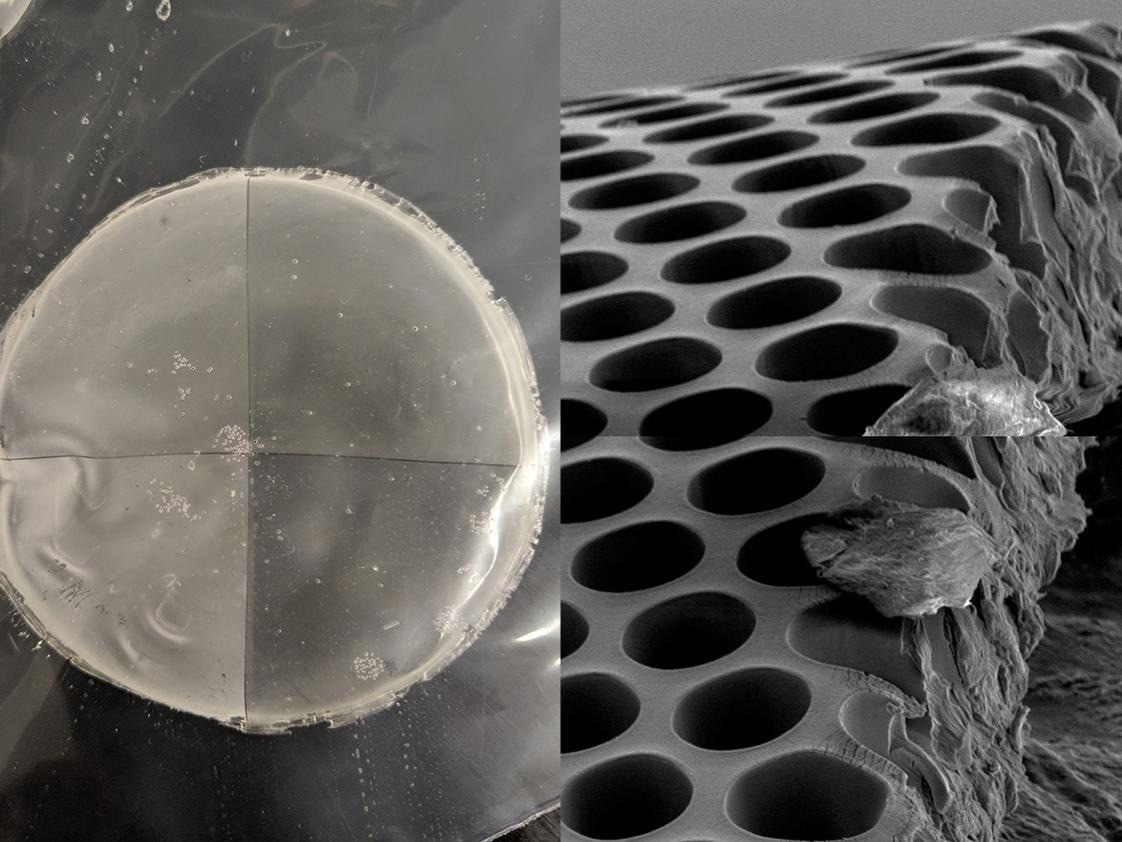Reviewed by Mila PereraSep 9 2022
U.S. Marines have to acquire and store sufficient drinking water to sustain them on missions since they have no access to clean water.
 Penn State researchers will fabricate membranes with different surface pattern geometries and sizes to use in membrane capacitive deionization. The full membrane is seen at the left, and at the right, a portion of the membrane is seen under an electron microscope. The tiny wells allow sodium and chloride ions to be filtered out of unclean water. Image Credit: Arges Lab. All Rights Reserved.
Penn State researchers will fabricate membranes with different surface pattern geometries and sizes to use in membrane capacitive deionization. The full membrane is seen at the left, and at the right, a portion of the membrane is seen under an electron microscope. The tiny wells allow sodium and chloride ions to be filtered out of unclean water. Image Credit: Arges Lab. All Rights Reserved.
Penn State University (PSU) scientists, headed by Chris Arges, PSU associate professor of chemical engineering, are involved in creating a practical purification option that is lightweight, portable, and user-friendly.
Arges and co-principal investigator Christopher Gorski, PSU associate professor of civil and environmental engineering, will utilize a $570,000, three-year grant from the Office of Naval Research to develop a water purification technique called membrane capacitive deionization (MCDI).
Although the bulk of global desalination utilizes a process known as reverse osmosis at centralized production facilities, it is not suitable for military teams, as it requires high-pressure piping and hardware and is difficult to operate in the field. MCDI, on the other hand, is effective, mobile, and energy efficient.
Chris Arges, Study Lead and Associate Professor, Chemical Engineering, Penn State University
Driven by solar or battery-powered electricity, MCDI uses ion-exchange membranes and porous electrodes to separate ions, such as chloride and sodium, from water. According to Arges, the technique is successful for brackish or ground water, but fails to purify extremely concentrated water sources like seawater adequately.
The electricity triggers the sodium ions to migrate across the cation exchange membrane to a negatively charged electrode, while chloride ions migrate across the anion exchange membrane to a positively charged electrode, a process that is known as the principle of electrosorption. Capturing the ions from the liquid leads to deionized, drinkable water.
Chris Arges, Study Lead and Associate Professor, Chemical Engineering, Penn State University
When greater quantities of water are treated in the MCDI unit, the electrodes become saturated with salt, rendering them unable to eliminate enough of it from the water. At that juncture, Arges states, the electrodes can be revived by decelerating the flow of water and switching the polarity of the cell.
“This step in the process wastes some of the water but it also produces electrical energy that can be recovered and applied to the next desalination cycle to lower the overall energy burden,” Arges said. “This allows MDCI to remain energy-efficient.”
To enhance MDCI’s effect on highly concentrated water sources, Arges and his team will remodel the electrochemical cell module employed in MCDI. Using tools from the Nanofabrication Lab in the Penn State Materials Research Institute, the team will create microscopic wells in an interlocking design on the membrane surface.
This expands the interfacial area between the electrodes and the membrane, improving contact and decreasing the distance that the chloride and sodium ions must travel to cross the membrane-electrode interface.
Moreover, the wells allow the electrode material to store more chloride and sodium ions, enabling users to purify water for more extended periods before turning to regeneration. Arges explained that, if effective, the enhanced MCDI unit could purify not only ground and brackish water but also seawater.
In an earlier study, Arges and his team effectively used similar membrane patterning to divide hydronium and hydroxide ions from water in bipolar membranes to create hydrogen and oxygen in an electrolysis cell.
Since the proposed approach for this grant has worked for us in the past, we believe the increased interfacial area will reduce ionic transport resistance, leading to cleaner water in greater quantities.
Chris Arges, Study Lead and Associate Professor of Chemical Engineering, Penn State University